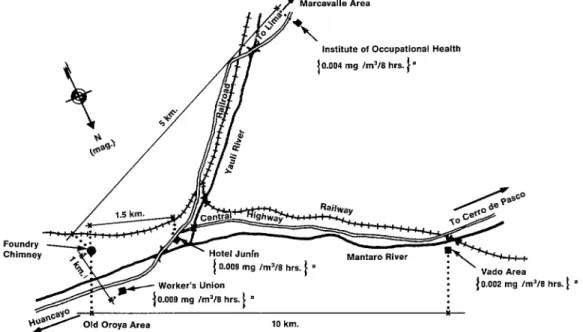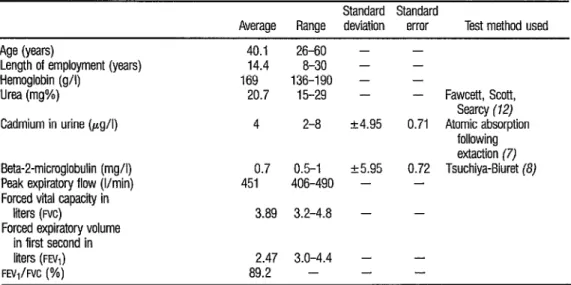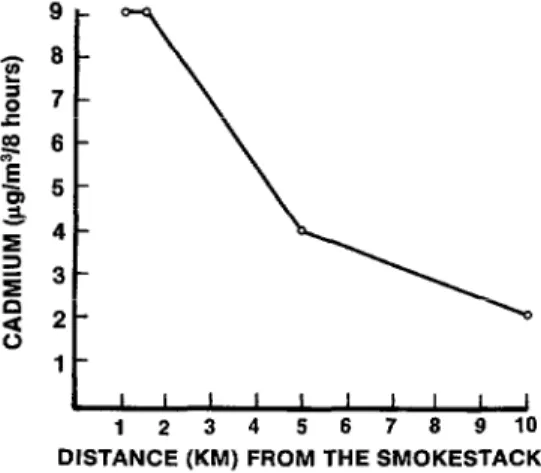C
ADMIUM POLLUTION
IN LA OROYA, PERU1
August0 K RamZrez2
I
NTRODUCTION La Oroya, an ore processing center and city of 40,000 inhabitants, is located about 3,800 m above sea level in Peru’s Central Andes (Figure 1). The Central Peru Mining Enterprise (Em- presa Minera de1 Centro de1 Peru, S. A., also known as Centromin Peti) has its metallurgical center here, where it pro- duces , in descending order, copper, lead, zinc, silver, gold, selenium, tellurium, cadmium, indium, sulfuric acid, arsenic trioxide, and other products. Its high- altitude foundry, which has the highest industrial smokestack in the world, emits a daily average of 10 tons of polluting solids, vapors, and fumes for a distance of approximately two kilometers; the plant also discharges additional pollu- tants into the Mantaro River that flows around the city. Centromin Peru’s Safety Department has detected high levels of environmental contamination as far as 10I This article also published in Spanish in the Boletin de la Ojcma Sanitaria Panamericana, Vol. 101, No. 5, 1986.
z Occupational Physician, Depattment of Occupational Medicine, Empresa Minera de1 Centro de1 Peti, S.A.. La Oroya, Peru.
kilometers away from the foundry’s cen- tral stack (Figure 2).
The element cadmium is used in alloys because it resists corrosion and in the manufacture of pigments, alkaline batteries, and other items. A respiratory irritant, cadmium is toxic to the kidneys and also causes a type of osteomalacia. Centromin Peti produces about 35,000
pounds of cadmium per month at La Oroya as a by-product of lead and zinc refining. Cadmium oxide (CdO) , formed in this process from CdS, is highly toxic.
Because of cadmium’s pres- ence and proven toxicity, in 1983 we un- dertook an evaluation of 40 Centromin Peti workers who were not exposed to cadmium by their work, but who did live in La Oroya, and who should therefore have shown signs of exposure to this element.
FIGURE 2. A map of part of the area potentially affected by efiluents from the la Oroya foundry smokestack, showing the distances from the smokestack to four sampling stations.
Marcavalle Area
Institute of Occupational Health
Mantaro River
:\ -I- Vado Area
i jO.002 mg /m3/9 hrs. \ ’ .
.
, .
10 km.
aSOUrce: Safety Department (Departamento de Segurldad), Centromln Perli. S A
M
ATERIALSAND METHODS
The Survey Subjects
The study, conducted during the summer, was carried out with male Centromin Peru workers who were not directly exposed to cadmium through their work, but who resided a minimum of six days per week in the city of La Oroya, and who worked in the produc- tion and administration offices, all of which are located between two and five kilometers from the foundry. Persons liv- ing within a one-kilometer radius of the foundry were excluded. We also excluded those workers whose duties caused them to enter the industrial facilities and those who showed any overt symptoms of ill-
ness. (It should also be noted that smok- ing is virtually nonexistent among inhab- itants of the Peruvian highlands.) From the remaining population of eligible per- sonnel, the 40 participating workers were selected at random (61.
Test Procedures
The level of cadmium in each subject’s urine was determined by means of atomic absorption spectrometry fol- lowing extraction (7), and the level of beta-2-microglobulin in the urine was found by the Tsuchiya-Biuret method (9). Functional respiratory testing was
performed using a Warren Collins elec- tronic spirometer with a digital display (3, 9). The values quantified were (a) peak expiratory flow (PEF), measured in
liters per minute; (b) forced expiratory volume in the first second (FEV~), mea- sured in liters; (c) forced vital capacity
(FVC), measured in liters; and (d) the ra- tio between FEV~ and FVC, expressed as a
percentage.
In addition, the air was sam- pled for the 480 minutes of each work shift, using the continuous collection technique described by Hanson (10) and Jacobs (1 I). An average of six samples
per shift was taken at each of the four points indicated in Figure 2. The ambi- ent temperature during the sampling pe- riod ranged from a daytime average at lo-12°C to a nighttime average of 3-6°C. The weather at this time was var- iable with sporadic showers.
IL SULTS
As Table 1 shows, the average age of the study subjects was 40.1 years and the level of urea in their blood (determined by the Fawcett-Scott- Searcy method-12) ranged from 15 to 29 mg % . Regarding cadmium in their urine, the average level found was 4 pg per liter, with the highest observed level being 8 pg and the lowest being 2 pg. The observed levels of beta-µglob- ulin in the subjects’ urine ranged from 0.5 to 1 mg per liter. None of the radio- logic results obtained indicated osteoma- lacia.
The parameters of pulmonary ventilatory function were within normal limits for the subjects’ altitude of resi- dence 3,800 m above sea level. All of the study subjects were nonsmokers.
Cadmium was found in the air tested, the average amount being 18
pg per cubic meter over 24 hours, within a range of 9.1 pg at 10 km from the foundry to 26.7 pg at 1 km from the foundry.
TABLE 1. Data obtained from 40 male test subjects regarding environmental cadmium pollulion in La Oroya, Peru.
Age tve=d
Length of employment (years) Hemoglobin (g/l)
Urea (mg%)
Cadmium in urine (pg/I)
Beta-2-microglobulin (mg/l) Peak expiratory flow (Vmin) Forced vital capacity in
liters (WC)
Forced expiratory volume in first second in liters (FN,)
FEV,/NC(%)
Standard Standard
Average Range deviation error Test method used
40.1 26-60 - - 14.4 8-30 - - 169 136-190 - -
20.7 15-29 - - Fawcett, Scott, Searcy (72) 4 2-8 24.95 0.71 Atomic absorption
following extaction (7) 0.7 0.5-I k5.95 0.72 Tsuchiya-Biuret (81 451 406-490 - -
3.89 3.2-4.8 - -
D
ISCUSSION Owing to the nature of its ac- tivities, and despite a variety of safety measures that have been adopted, La Oroya is an industrial city with pollution problems. Moreover, in the past, protec- tion for local residents was always pro- vided by actions designed to keep the concentrations of certain more obvious pollutants within permissible limits- these pollutants being lead, arsenic, and sulfur dioxide. Cadmium, which has a biological half-life of 30 years and cumu- lative effects ranking in toxicologic im- portance with lead and arsenic (>I, was overlooked.The portal of entry for cad- mium in our population is through the respiratory tract. That is, the element en- ters as airborne CdO. Figures 2 and 3 show the levels of contamination found at the sampling sites around La Oroya. It should be pointed out that the metallur- gic process for cadmium at Centromin Peti is continuous.
FIGURE 3. Levels of airborne cadmium pollution at vary- ing distances from the La Oroya foundry smokestack (data provided by the Centromin Per0 Safaty Depart- ment).
1 2 3 4 5 6 7 8 9 IO DISTANCE (KM) FROM THE SMOKESTACK
The maximum allowable air- borne limits recommended by WHO for industrial exposure to cadmium range from 0.1 to 0.2 pg per cubic meter in eight hours (13, 14). When we reviewed the literature on this subject, we found no maximum values established for non- occupational exposures. However, actual exposure levels found by studies in vari- ous countries give a rough idea of the problem: in the United States the Na- tional Air Sampling Network found lev- els in 20 large cities that averaged be- tween 0.006 and 0.036 pg per cubic meter (5/. In New York, Kneip et al. (IS) recorded values of 0.014 to 0.023 pg per cubic meter. In Poland, Just and Ke- lus (16) obtained values ranging from
0.002 to 0.05 pg per cubic meter. In Tokyo, Nagata et al. (17) found average 24-hour values ranging from 0.010 to 0.053 pg per cubic meter. And in Stock- holm, Piscator (2) reported finding an average weekly value of 0.005 pg per cu-
bic meter. s
As is evident, all these values 2 are far below those found by the Safety - Department of Centromin Per% for La 5 Oroya, where the average value was 18
pg per cubic meter in 24 hours, within a i2 range of 9.1 pg per cubic meter 10
~
kilometers from the foundry and 26.7 pg 2
per cubic meter one kilometer from the 2 foundry.
In addition, the Table 1 data 8 show that the level of cadmium in urine 2 (which is the indicator generally used to 2 assess the accumulation of cadmium in people) exceeded the levels found in 3 other cities with cadmium pollution
2
problems. Specifically, the average level 3 found in the La Oroya test subjects (4 pg . per liter of urine, with a standard devia- tion of i 4.95 and a standard error of
,$ E 2
0.71) was considerably higher than that found in the Federal Republic of Ger- many (1 ,ug per liter--S), the United States (1.6 pg per liter-d), Sweden (0.25 pg per liter-p), and Japan (0.47 pg per liter--18). it should be noted that we have referred here exclusively to those researchers who calculated the level of cadmium in urine by means of the same method (atomic absorption after extrac- tion) that we employed. Therefore, the results appear to demonstrate that the average cadmium concentration in urine was considerably higher in our study group than it was in the study popula- tions of the countries cited.
Regarding beta-2-microglob- ulin (an indicator of nephrotoxicity), the average value obtained in our study (0.7 mg per liter with a standard deviation of * 5.95 and a standard error of 0.72) was nearly double the 0.4 mg per liter con- sidered normal. To date it has not been possible to show the existence of pro- teinuria specific for cadmium exposure. However, all researchers appear to agree that beta-2-microglobulin, without be- ing specific, is always found at higher levels in the urine of cadmium-exposed workers. This suggests tubular-type pro- teinuria caused by reduced resorption of protein in the renal tubules (9). Vigliani
(19) has suggested that cadmium acts at the renal level by altering the catabolism of the microglobulins. Whatever the u
5
case, and despite the fact that our study subjects were found to have normal lev- .
z els of urea in their blood (15-29 mg % ), % the relatively high levels of beta-2-mi- .g
9, * 8 2
378
croglobulin clearly demonstrated the chronic subclinical renal aggression to which this study group was exposed.
With respect to the pulmo- nary ventilatory function (PVF), cases of acute edema in the lungs have been re- corded among people subjected to sud- den and accidental exposure to cadmium vapors or fumes, while subjects exposed occupationally (i.e., in a chronic man- ner) show emphysematous alterations (20, 21). However, none of these altera- tions have been found in subjects who were not occupationally exposed (22). It is therefore not surprising that our study failed to show PVF alterations, the find- ings obtained being in keeping with val- ues found for normal, nonsmoking sub- jects residing at high altitude (2.3).
C
ONCLUSIONSThese results lead to several conclusions. In the first place, it seems clear that the La Oroya population is ex- posed to quite high levels of cadmium oxide vapors and/or fumes. The subjects tested had a normal pulmonary ventila- tory function and yielded no evidence of nephrotoxicity or osteomalacia. How- ever, the levels of cadmium found in their urine indicated an accumulation of this element in their bodies, and beta-2- microglobulin levels were above “nor- mal” limits.
S
UMMARY The city of La Oroya is a Peru- vian mining and metals refining center with a population of about 40,000 in- habitants situated about 3,800 meters above sea level in the Andes Mountains. The smokestack at its foundry, rated the highest industrial smokestack in the world, emits some 10 tons of pollutingvapors, fumes, and particulates per day. The plant also discharges additional pol- lutants into the Mantaro River that flows around the city.
The study described here, conducted by medical personnel at the Central Peru Mining Enterprise that op- erates the foundry, was designed to assess levels of cadmium in workers residing in La Oroya who were not occupationally exposed to that element. Past health measures directed at keeping environ- mental pollution in check had not in- volved cadmium specifically, being di- rected instead at other potentially hazardous materials.
Air sampled at four sites lo- cated one to 10 kilometers from the smokestack was found to contain unusu- ally high levels of cadmium oxide. The 40 workers included in the study popula- tion did not show obvious signs of cad- mium poisoning, exhibiting pulmonary ventilator-y functions in the normal range for nonsmoking high-altitude residents and having normal levels of urea in the blood. However, abnormally high levels of cadmium in their urine pointed to ac- cumulation of the element in their bodies; and high levels of beta-2-mi- croglobulin in their urine demonstrated exposure to chronic subclinical renal ag- gression. All in all, these findings appear to justify more extensive epidemiologic
study of the cadmium problem in La Oroya, study that should include screen- ing of different age groups and testing for possible contamination of nearby crops.
RE
FERENCESNordberg, G. F. Urinary Blood and Fecal Cad- mium Concentrations as Indices of Exposure and Accumulation. In: Proceedines of the 17th International Congress on Oc&pakonal Heah%. Ed. Gr$rca Didot S.C.A.. Buenos Ai- res, Argentina, 1974.
Piscator, M. Cadmium Toxocity: Industrial and Environment Experience. In: Proceedings
of the Seventeenth International Congress on Occzcpational Health. Ed. GrZca Didot, S.C.A., Buenos Aires, Argentina, 1974.
Mappes, R. Normaler cadmiumgehalt des urins. Arbeitsmedizin-SoziaL Medizin-Arbeits- hygiene 5:142, 1969.
Imbus, H. R., J. Cholak, L. H.-Miller, and T Sterling. Boron, cadmium, chronium, and nickel in blood and urine. Arch Environ Health 6:286, 1963.
Friberg, L., M. Piscator, G. F. Nordberg, and T Kjelistrom. Cadmium in the Environment (second ea.). CRC Press, Cleveland, 1974.
Fisher, R. A., and E Yates. Ebelas estatriticas
para pesquka em biologia, medicina y agri cdtura. Poligono, Sao Paulo, 1971.
Pulido, P, K. Fuwa, and B. L. Vallee. Deter- mination of cadmium in biological materials b
x atomic absorption spectrometry. AnaL Bio- c em 14~393, 1966.
Tsuchiya, K. Proteinuria of workers exposed to cadmium fumes and the relationship to con- centration in the working environment. Arch Environ Heakb 14375, 1967.
9 Nordberg, G., L. Friberg, and M. Piscator. Respiratory Effects and Dose-Response Rela- tionships. In: L. Friberg, M. Piscator, and G. Nordberg. Cadmium in the Environment. CRC Press, Cleveland, 1971, pp. 30-44.
11 Jacobs, M. B. The Chemical Analysis of Air PO&ants. Interscience Publishers, New York,
Henry, R. J. Clinical Chemiby: Prim$les and Technics. Hocher, 1964.
Internationai Labour Office. Encyclopedia of
Occzlpationa/ Heabh and Safety. Geneva, 1974.
12
13
14
15
National Institute for Occupational Safety and HeaIth/OccuoationaI Safetv and Health Ad- ministration. APocket Guide’ to Chemical Haz- a&r. U.S. Department of Health, Education, and Welfare, and U.S. Department of Labor, Washington, D.C., 1978.
-. Kneip, T. J., M. Eisenbud, C. D. Strehlow, and P. C. Freundenthal. Airborne particulates in New York City. J Air Pollat Control Assoc 20: 144, 1970.
19GO.
16 Just, J., and J. Kelus. Cadmium in the air at- mosphere of ten selected cities in Poland. ROGZ Panstw ZakL H& 22~249, 1971.
17 Nagata, R., T. Hirono, H. Yamazaki, K. Asa- kuno, K. Nakano, and T. Odaira. Air Pollu- tion by Heavy Metals Contained in Particulate Matter in Tok o. In: Annual Report of the To- kyo Metropo ztan Research Institute for Envi- 1 ronmentaL Protection. Cited by L. Friberg, et al. Cadmium in the Environment (second ea!). CRC Press, Cleveland, 1974.
18
19
20
21
22
23
Katagiri, Y., M. Tati, H. Iwata, and M. Kawai. Concentration of cadmium in urine by age. MedBiol82:239, 1971.
Vigliani, E. C., B. Pernis, and A. Luisa. Etudes biochimiques et immunologiques sur la nature de la proteinurie cadmioue. MedLuv 571322, 1966. -
Bonnell, J. A. Emphysema and proteinuria in men casting copper-cadmium alloys. Br J Ind Med 12:181, 1955.
Katanttis, G. Respiratory function in men casting cadmium alloys. I: Assessment of ven- tilatory function. BrJZndMed 13:30, 1956.
Peacock, P. The Association of Serum Cad- mium Values with Indices of Cardiovascular and Other Diseases and Certain Environmen- tal Factors. Cited by L. Friberg, M. Piscator, G. F. Nordberg, and T Kjellstrijm. Cadmibz in the Environment (second ed). CRC Press. Cleveland, 1974, chapter 6.
Ramirez , A. FunciBn ventilatoria pulmonar en trabajadores mineros de altura. In: Actas Pri- meras Jornadas de Medicina y CimgLa de AL tnra, 1978. Cuerpo Medico, Hospital General de Chulec, La Oroya, Per& 1978.


